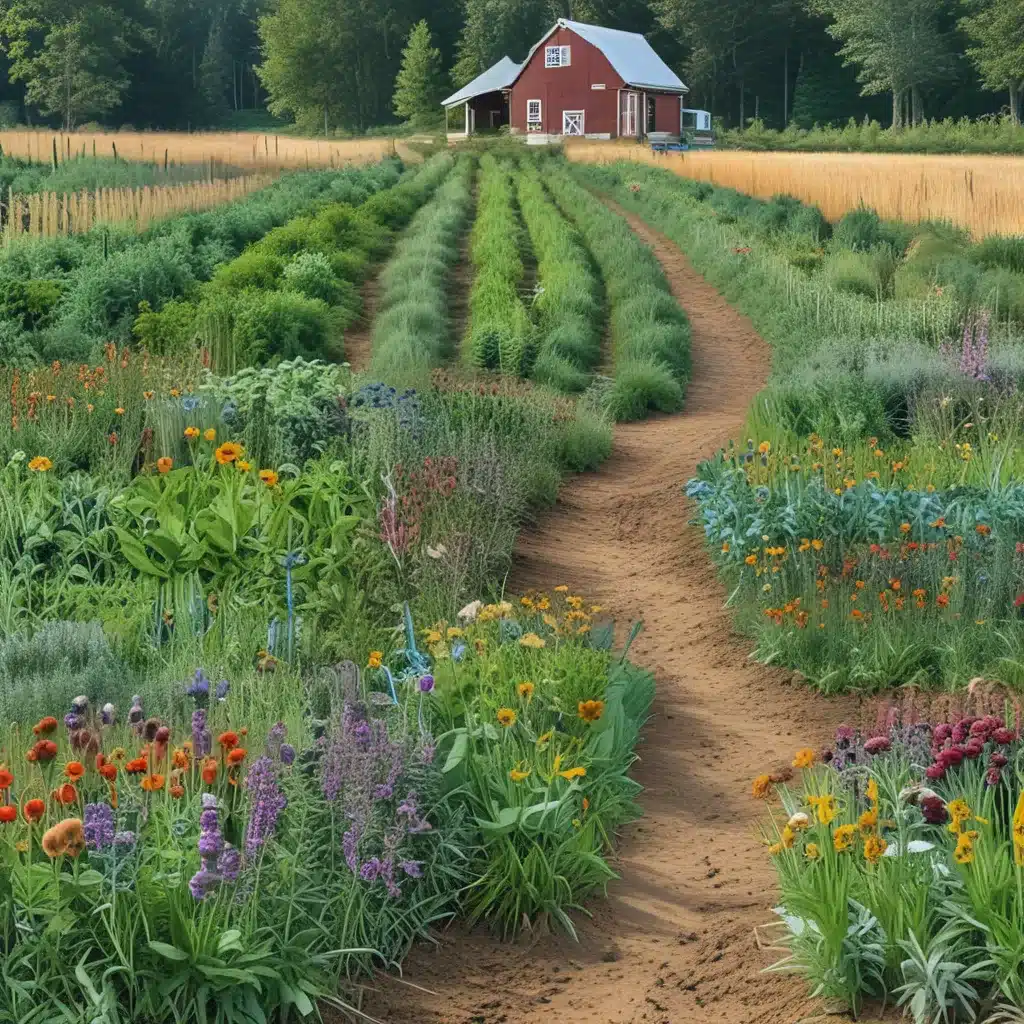
Harnessing the Rhythm of Nature
As I step out onto the rolling fields of Thornap ple CSA, the symphony of life surrounds me. Buzzing bees dart between vibrant wildflowers, while birds chirp merrily overhead. This isn’t your typical farm – it’s a living, breathing ecosystem that hums with biodiversity. And it’s all by design.
You see, when I first took on the challenge of revamping our CSA’s layout, I knew I wanted to do more than just optimize for crop yields. My vision was to create a farm that not only nourished our members, but also supported the delicate web of life that underpins a healthy environment. It was a daunting task, but one that filled me with a sense of purpose.
Honoring the Land’s Wisdom
As I dove into research, I discovered a wealth of inspiring examples from around the world. The European Union’s Circular Economy Action Plan highlighted the crucial role of biodiversity in building a sustainable future. And learning about innovative projects like Namu Farm’s seed-saving efforts in California (as detailed in this fascinating article) further inspired me to think outside the box.
I realized that true biodiversity wasn’t just about planting a few pretty flowers – it was about honoring the intricate relationships that had evolved over centuries between the land, the plants, and the myriad creatures that call it home. It was about embracing the rhythm of nature, rather than trying to impose our own rigid order.
Designing for Diversity
Armed with this newfound perspective, I set out to reimagine our farm layout. Gone were the stark rows of monoculture crops, replaced by a tapestry of diverse plantings that mirrored the natural world.
First, I mapped out the different microclimates and soil types across our fields, identifying areas that would be ideal for specific crops and companion plants. Then, I drew inspiration from the concept of “polycultures” – integrating multiple complementary species into each growing area to foster mutual support and resilience.
For example, in one section, I planted our signature heirloom tomatoes alongside fragrant basil, nasturtiums, and marigolds. The basil helps deter pests, the nasturtiums attract beneficial insects, and the marigolds’ strong scent masks the tomato plants’ attractiveness to herbivores. It’s a delicate dance, but one that ultimately yields bountiful harvests while nurturing the surrounding ecosystem.
Embracing the Unexpected
Of course, designing a nature-friendly farm layout isn’t always a straightforward process. There have been plenty of unexpected twists and turns along the way. Just last season, I discovered a thriving colony of ground-nesting bees in a seemingly unassuming corner of the property. Instead of removing them, I decided to create a “bee sanctuary” – leaving the area undisturbed and planting additional nectar-rich flowers to support their population.
And then there was the time I opted to let a patch of “weeds” flourish, only to watch in awe as it transformed into a vibrant pollinator haven, buzzing with butterflies and hummingbirds. It was a humbling reminder that nature often knows best, and that our role as stewards is to facilitate its inherent wisdom, not try to conquer it.
Cultivating Community Connections
As I’ve delved deeper into this journey of biodiversity-focused farm design, I’ve discovered that it’s not just about the land itself – it’s also about the people who interact with it. That’s why I’ve made a concerted effort to engage our CSA members in the process, inviting them to participate in workshops, volunteer days, and even citizen science projects.
Just as the EU’s Circular Economy Action Plan emphasizes, fostering a sense of community ownership and investment is crucial for the long-term success of sustainable initiatives. By empowering our members to become active stewards of the land, we’re not only cultivating a deeper appreciation for the natural world, but also nurturing a powerful network of allies in our mission to protect it.
Embracing the Messy Beauty of Nature
As I reflect on the evolution of our farm layout, I can’t help but marvel at the sheer complexity of the living systems we’ve set in motion. It’s a far cry from the neat and tidy rows I once envisioned, with every plant and animal finding its rightful place in the grand tapestry of life.
Sometimes, it can feel overwhelming – like I’m navigating a constantly shifting maze of interdependencies and unexpected challenges. But then I remember the wise words of the seed-saving visionaries at Namu Farm: “Theres a way that my farm has really made me sit with the discomfort and messiness of process knowing that sometimes in change you have to endure a little bit of heartbreak.”
Because that’s the thing about true biodiversity – it’s not always clean and orderly. It’s messy and unpredictable, with setbacks and surprises around every corner. But it’s also breathtakingly beautiful, a symphony of life that sustains us in ways we’re only beginning to understand.
And so, I embrace the chaos, trusting in the wisdom of nature and the resilience of the ecosystem we’re cultivating. Because in the end, that’s what a truly nature-friendly CSA farm is all about – not just feeding our members, but nourishing the very fabric of life itself.



